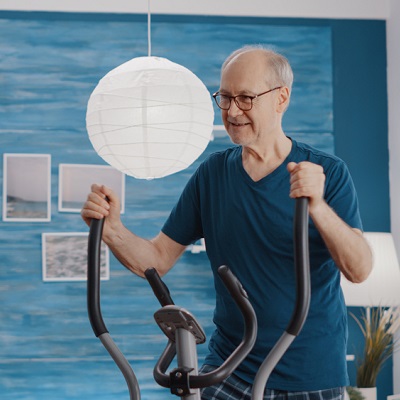 Elliptical machines are growing in popularity. If you’re trying to decide between a treadmill and an elliptical, these are some facts to keep in mind. As the name suggests, an elliptical has pedals that move in an oval, or elliptical, shape. Unlike running on a treadmill, your feet remain in contact with the pedal the whole time so you get a lower impact workout while still targeting your legs and cardiovascular system. You can even get a full body workout on many models.
Elliptical machines are growing in popularity. If you’re trying to decide between a treadmill and an elliptical, these are some facts to keep in mind. As the name suggests, an elliptical has pedals that move in an oval, or elliptical, shape. Unlike running on a treadmill, your feet remain in contact with the pedal the whole time so you get a lower impact workout while still targeting your legs and cardiovascular system. You can even get a full body workout on many models.
General Guidelines for Elliptical Machines
1 – Use good posture. Avoid injuries and shape up faster by maintaining correct form. Stand up straight with your chest forward and shoulders back. Tense your abdominal muscles.
2 – Position your feet. Put your feet in the middle of the pedal. Light pressure is all you need.
3. Pedal forwards and backwards. Beginners usually start out with a forward direction that works the quadriceps. Once you’re comfortable, you can also pedal backwards to target the backs of your legs.
4 – Set the resistance. Increasing the resistance intensifies the workout. You’ll burn more calories and tone your legs.
5 – Engage your upper body. Look for machines with handles and poles that simulate activities like cross country skiing. They’ll enable you to exercise your lower body as well as your back, shoulders, and arms all at the same time.
6 – Count your calories. If you’re trying to lose weight, note that elliptical machines usually burn a few less calories than running on a treadmill or the track. However, they burn more calories than bicycling at the same pace. Figure on 75 calories every 10 minutes at a moderate pace.
7 – Vary your sessions. Diversify your routine by adjusting the resistance and your speed. You can also alternate between different activities so you’re off the machine some days.
Guidelines for Buying an Elliptical Machine for Your Home
1 – Research your options. You have a wide range of prices and features to choose from. Expect to pay over $1,000 for a good quality machine.
2 – Take a test run. Spend at least ten minutes using any machine before you buy it. It’s the best way to tell if it feels smooth and suits your proportions.
3 – Keep them away from children. Moving parts can be a hazard for children. Give them something safer to play with like their own exercise ball.
4 – Ask about assembly. Proper assembly prevents accidents and makes your investment last longer. Plus, elliptical machines are tall and often weigh over 500 pounds, so you may want help lifting the heavy parts.
Additional Tips
1 – Train for a race. If you’re a serious runner or training for competition, you probably want to spend some time on the track or treadmill. Running on an elliptical is different from natural conditions where your feet leave the ground.
2 – Adjust the console. Gym machines are built to serve a variety of body shapes and sizes. To get more accurate measurements of how many calories you burn, enter your individual weight and other data.
3 – Talk with your doctor. While elliptical machines provide a low impact workout, that may still be too stressful for some conditions. Check with your doctor if you have knee pain or other symptoms. A stationary bike may be a better solution for you.
Elliptical machines are a safe and effective form of exercise for most people. Make them a regular part of your routine or a rainy day substitute for the activities you usually do outdoors.






